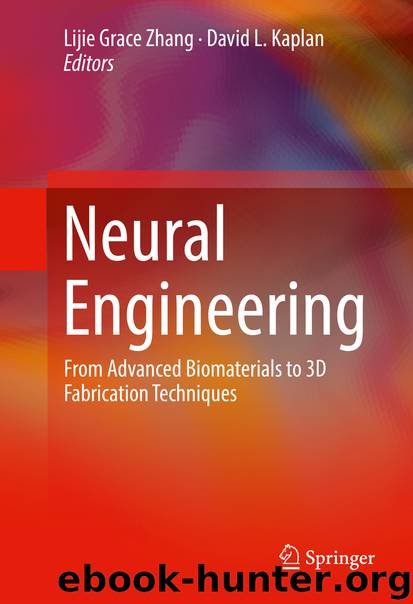Neural Engineering by Lijie Grace Grace Zhang & David L. L. Kaplan

Author:Lijie Grace Grace Zhang & David L. L. Kaplan
Language: eng
Format: epub
Publisher: Springer International Publishing, Cham
Aligned electrospun poly (l-lactic acid-co-caprolactone) (PLCL) nanofibers have been coated with MWCNTs following anionic modification with potassium sodium tartrate (Jin et al. 2011a, b). SEM analysis revealed MWCNT-coated PLCL fibers to be generally rougher than the PLCL fibers alone; diameters were measured to be between 1.3 and 1.5 μm. Jin et al. assessed neurite outgrowth of rat dorsal root ganglia neurons cultured on aligned MWCNT-coated PLCL fibers for up to 9 days by fluorescence microscopy after staining with Phalloidin to visualize actin filaments. Compared to control-aligned PLCL fibers, PC12 neurite length on aligned MWCNT-coated PLCL fibers was significantly greater. Notably, PC12 FAK expression, indicative of integrin-mediated signal transduction involved in neurite outgrowth, was assessed on the MWCNT-coated PLCL fibers by western blot band intensity and found to be higher compared to the control (Jin et al. 2011a).
In recent years, graphene has garnered much attention as a potential conductive material in the development of electroactive scaffolds. Graphene deposited via LbL assembly onto PCL films and nanofibers enhanced primary cortical neuron attachment and spreading, and supported branched and elongated neurites compared to unmodified PCL (Zhou et al. 2012). Sherrell and colleagues from the Wallace group were the first to report electrical stimulation of PC12 cells on graphene. Following 8 h of electrical stimulation daily for 3 days, a dramatic increase was observed in neurite length and connectivity compared to unstimulated cells cultured on bilayer graphene-coated 50:50 PLGA substrates (Sherrell et al. 2014). Both of these studies validate the ability to develop biocompatible conductive composites utilizing graphene. The latter study employed drop-casting of the biopolymers over graphene during fabrication. The self-assembly layer-by-layer fabrication technique in the Zhou et al. study could find wider application for incorporating graphene in biopolymer composites for electrical stimulation. In this method, graphene-polyelectrolyte multi-layers (PEMs) were self-assembled onto the substrate after surface activation with polythyleneimine by soaking in alternating solutions of a colloidal suspension of graphene nanosheets in a heparin solution (anionic layer) and a poly-l-lysine (PLL) solution (cationic layer) (Zhou et al. 2012). Elsewhere, the Wallace group has reported successful preparation of stable dispersions of chemically converted graphene (CCG) in dimethylformamide (DMF) , which led to the fabrication of covalently linked graphene/polycaprolactone composites (cPCL-CCG) (Sayyar et al. 2013). Material characterization of the PCL-CCG composites confirmed homogenous dispersion of the graphene nanosheets within the PCL polymer matrix. The conductivities of the cPCL-CCG composites with 0.5 and 5 % CCG were ~10 and ~11 orders of magnitude greater than pristine PCL (Sayyar et al. 2013). Incorporation of CCG into PCL scaffolds did not alter biocompatibility; films robustly supported the attachment and proliferation of 3 different cell types: L929 fibroblasts, C2C12 myoblasts, and PC12 cells (Sayyar et al. 2013).
A summary of the studies involving the other ICPs as well as piezoelectric and nanostructured carbons is provided in Table 5.2. Table 5.2A summary of conductive scaffolds
Download
This site does not store any files on its server. We only index and link to content provided by other sites. Please contact the content providers to delete copyright contents if any and email us, we'll remove relevant links or contents immediately.
| Administration & Medicine Economics | Allied Health Professions |
| Basic Sciences | Dentistry |
| History | Medical Informatics |
| Medicine | Nursing |
| Pharmacology | Psychology |
| Research | Veterinary Medicine |
Periodization Training for Sports by Tudor Bompa(8088)
Why We Sleep: Unlocking the Power of Sleep and Dreams by Matthew Walker(6540)
Paper Towns by Green John(5017)
The Immortal Life of Henrietta Lacks by Rebecca Skloot(4441)
The Sports Rules Book by Human Kinetics(4204)
Dynamic Alignment Through Imagery by Eric Franklin(4041)
ACSM's Complete Guide to Fitness & Health by ACSM(3930)
Kaplan MCAT Organic Chemistry Review: Created for MCAT 2015 (Kaplan Test Prep) by Kaplan(3901)
Introduction to Kinesiology by Shirl J. Hoffman(3689)
Livewired by David Eagleman(3616)
The River of Consciousness by Oliver Sacks(3490)
The Death of the Heart by Elizabeth Bowen(3477)
Alchemy and Alchemists by C. J. S. Thompson(3415)
Bad Pharma by Ben Goldacre(3199)
Descartes' Error by Antonio Damasio(3183)
The Emperor of All Maladies: A Biography of Cancer by Siddhartha Mukherjee(3010)
The Gene: An Intimate History by Siddhartha Mukherjee(3004)
The Fate of Rome: Climate, Disease, and the End of an Empire (The Princeton History of the Ancient World) by Kyle Harper(2970)
Kaplan MCAT Behavioral Sciences Review: Created for MCAT 2015 (Kaplan Test Prep) by Kaplan(2894)
